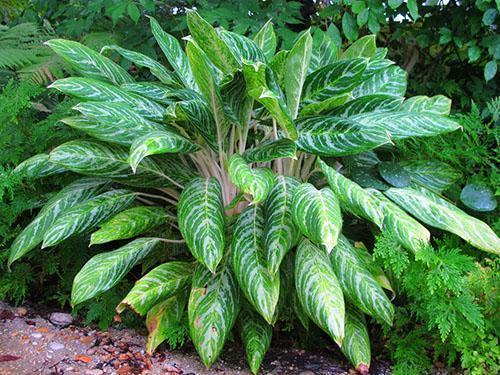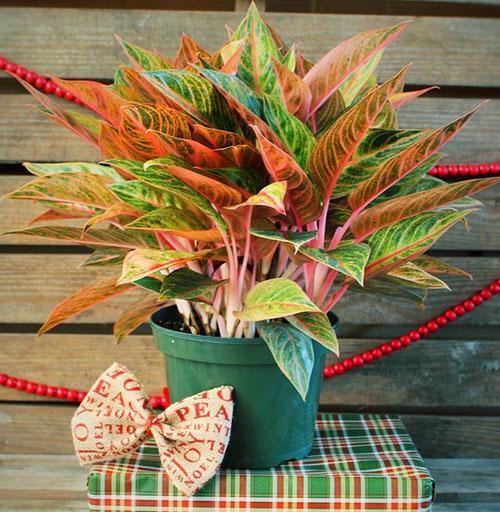Plant with multicolored foliage - aglaonema flower
 The tropical flora is incredibly beautiful and diverse. And botanists will have to reveal its secrets for many years to come. Aglaonema, belonging to the greatest Ariod family in the plant world, is an indigenous inhabitant of a vast region in southeast Asia.
The tropical flora is incredibly beautiful and diverse. And botanists will have to reveal its secrets for many years to come. Aglaonema, belonging to the greatest Ariod family in the plant world, is an indigenous inhabitant of a vast region in southeast Asia.
The birthplace of aglaonema and the conditions for the existence of the plant

Diversity species of aglaonema owes to various natural conditions in remote corners of the range, as well as to the isolated location of these regions. With the beginning of the development of Southeast Asia, the flora of the region began to be seriously studied. Many ornamental houseplants well known today have been discovered and described, including aglaonema.
Wild species of aglaonema in their homeland live in the lower tier of a broad-leaved forest, content with shaded areas under tree crowns, along streams and other bodies of water. Anglaonema does not require a lot of nutrient soil to develop.
Like other Aroid species, the plant easily adapts to living on rocky ledges with a small layer of humus, on peat bogs and soil, under the surface of which the roots of tropical trees are densely intertwined.
Although the culture is widespread in its homeland, it came to Europe from Malaysia, provoking delightful responses from gardeners and tropical flora lovers.
 The history of domestication and cultivation of aglaonema began in the 19th century, and for more than a century and a half the plant has been considered one of the most interesting and unusual inhabitants of the tropics. The specimens of the aglaonema flower that fell into the collection of the British Botanic Garden laid the foundation for breeding work, as a result of which many hundreds of indoor varieties and hybrids popular with flower growers were obtained.
The history of domestication and cultivation of aglaonema began in the 19th century, and for more than a century and a half the plant has been considered one of the most interesting and unusual inhabitants of the tropics. The specimens of the aglaonema flower that fell into the collection of the British Botanic Garden laid the foundation for breeding work, as a result of which many hundreds of indoor varieties and hybrids popular with flower growers were obtained.
Indoor flower aglaonema: structure and features
At first glance, Aglaonema is very similar to Dieffenbachia, which is not surprising, because the plants are close relatives and have many similarities.
 Aglaonema is an evergreen, herbaceous plant, depending on the species, reaching a height of 60–150 cm. Young specimens, which often find themselves in a grower's house, practically do not have a stem, but look like compact leaf rosettes above the ground level. But as it develops, the indoor flower aglaonema forms an erect or creeping dense stem, densely planted with leaves.
Aglaonema is an evergreen, herbaceous plant, depending on the species, reaching a height of 60–150 cm. Young specimens, which often find themselves in a grower's house, practically do not have a stem, but look like compact leaf rosettes above the ground level. But as it develops, the indoor flower aglaonema forms an erect or creeping dense stem, densely planted with leaves.
Most of the home-grown varieties readily branch, but in adult specimens, the lower parts of the stem are bare, and the foliage is located only at the top. At the same time, smooth internodes, almost not covered with scales, can be green, variegated, pink, white or red. The color of the stems, petioles and foliage of a plant depends entirely on the variety of aglaonema flower grown. And here the tropical genus can be considered the record holder for the number of unique shades and patterns.
The main value of the plant is its unique decorative foliage. The shape of dense leaf plates with pronounced veins can vary from oval to wedge-shaped.Juvenile, or the foliage of young plants, often has heart-shaped outlines, but as it grows, adult leaves appear on the aglaonema, completely corresponding to the species and variety. But the variety of shades on the leaves of the aglaonema flower can be the envy of even lush blooming crops.
Among indoor aglaonems, there are practically no plants with smoothly colored leaves, but specimens with edged, striped and spotted leaves are presented in abundance.
 On the leaf plates of the aglaonema flower shown in the photo, you can see all the shades of not only the green color traditional for the plant world, but also the whole gamut of purple, lilac and red.
On the leaf plates of the aglaonema flower shown in the photo, you can see all the shades of not only the green color traditional for the plant world, but also the whole gamut of purple, lilac and red.
 What novice growers mistake for an aglaonema flower is its inflorescence and a cover covering the ear, a leaf modified during evolution. Compared to other aroid species, for example, anthuriums or spathiphyllums, bred due to large decorative inflorescences, the flowering of aglaonema is not of great interest.
What novice growers mistake for an aglaonema flower is its inflorescence and a cover covering the ear, a leaf modified during evolution. Compared to other aroid species, for example, anthuriums or spathiphyllums, bred due to large decorative inflorescences, the flowering of aglaonema is not of great interest.
The shape of the veil of the aglaonema flower depends on the species and variety and can vary significantly. Along with oval and even rounded bracts, you can see rather narrow concave veils of a greenish, white or yellowish hue.
The inflorescence of aglaonema in the form of a dense cylindrical ear consists of a shortened female zone and a larger male zone, located from the lower third to the top. The pollinators of the tiny flowers of the aglaonema, united in the cob, are naturally occupied by insects. They are attracted by a veil imitating a petal and a sweet viscous liquid appearing on the stamens.
 The berries formed after pollination of the aglaonema flower contain oval, rather large seeds. The fruit itself has a spherical or elongated shape. The color of the berry varies from yellow to bright red, and a juicy pulp is hidden under the dense skin. In nature, aglaonema multiplies both vegetatively and with the help of seeds. Ripe aglaonema berries attract the attention of small animals and birds, which, by eating the fruits, can carry hard grains that are not damaged in the digestive tract over long distances.
The berries formed after pollination of the aglaonema flower contain oval, rather large seeds. The fruit itself has a spherical or elongated shape. The color of the berry varies from yellow to bright red, and a juicy pulp is hidden under the dense skin. In nature, aglaonema multiplies both vegetatively and with the help of seeds. Ripe aglaonema berries attract the attention of small animals and birds, which, by eating the fruits, can carry hard grains that are not damaged in the digestive tract over long distances.
Although the appearance of berries on aglaonema is not uncommon, at home it is better to propagate the flower vegetatively, because most of the indoor plants of this genus are hybrids that do not transmit their properties by seeds.
Aglaonema: how is the plant useful or dangerous?
 Since 1885, when Aglaonema was brought to the shores of the Old World, the plant has invariably attracted the attention of all lovers of decorative deciduous crops.
Since 1885, when Aglaonema was brought to the shores of the Old World, the plant has invariably attracted the attention of all lovers of decorative deciduous crops.
However, soon after the planting of plants in the Royal Botanic Gardens, it was discovered that all aglaonema tissues contain some caustic compounds that can have a local irritant or corrosive effect on mucous membranes and sensitive skin areas.
Today it is well known that the toxic effects of aglaonema juice are characteristic of all members of the Aroid family, containing calcium oxalate.
This salt of oxalic acid in the tissues of the aglaonema is dangerous in the presence of special susceptibility. You should take special care of the plant if there are injuries, cuts or abrasions on the skin of your hands. In this case, it is better to use gloves. You should not allow the proximity of a bright room culture to young children who are able to taste a colorful sheet "by the tooth".
 Although aglaonema is not poisonous, for cats and other pets with an interest in plants, close acquaintance with it can result in intestinal problems and irritation of the mucous membranes. If you choose the right place for the plant, the danger of aglaonema is a hundredfold compensated for by its great benefits.
Although aglaonema is not poisonous, for cats and other pets with an interest in plants, close acquaintance with it can result in intestinal problems and irritation of the mucous membranes. If you choose the right place for the plant, the danger of aglaonema is a hundredfold compensated for by its great benefits.
Why is aglaonema useful? First of all, the fact that, like other indoor crops, it has a beneficial effect on indoor air quality, saturating it with oxygen and negative ions. The plant is able to absorb substances harmful to humans that enter the room from the external environment, as well as fumes from artificial finishing materials.
The use of aglaonema also consists in its phytoncidal properties, due to which the number of pathogenic bacteria and streptococci in the air decreases.
 Bioenergy specialists also talk about the beneficial energetics of Aglaonema plants. Placing a pot of this vibrant indoor crop near your desk or in an office where there is intense daily work, the plant will help you focus and collect your thoughts. Colorful foliage, even by its appearance, can help relieve stress, calm down and focus yourself on the difficult tasks.
Bioenergy specialists also talk about the beneficial energetics of Aglaonema plants. Placing a pot of this vibrant indoor crop near your desk or in an office where there is intense daily work, the plant will help you focus and collect your thoughts. Colorful foliage, even by its appearance, can help relieve stress, calm down and focus yourself on the difficult tasks.